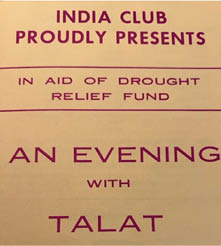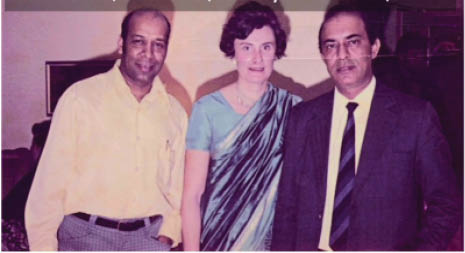I recently received a package from the U.S.A. by post. It was a book sent to me by the current President of the IAM – India Association of Minnesota. The book is about the history of IAM, which was founded as a community club in 1973 to represent the culture and heritage of the Indian-Americans settled there. This year, they’re celebrating the 50th anniversary of establishing this club.
There’s a very interesting story behind how all this is connected to one of India’s Golden Era legends, Talat Mahmood. The singer who was not just independent India’s first singing star, he had other pioneering facets to his career as well. And I continue to discover these facets in the process of writing his biography.
He was the first-ever playback singer from India to start world tours as early as 1956 in the peak of his career. But when his film
In those early days, Talat already had an agent in New York. Talat’s music tours helped ascertain where the Indian-American population was present and willing to organise shows of Hindi film concerts. The first generation of Indian immigrants would long to have someone visit from India and play them the music of their homeland. Many of these immigrants became rich businessmen and established cultural clubs that started inviting singers from India. Inevitably, Talat was often the first singer to perform for them, which set the ball rolling for the entire film music industry. He ended up charting the path for other singers like Mohd Rafi, Lata Mangeshkar, Kishore Kumar, and Mukesh, who followed suit. Careers of many concert organisers in the U.S. got established through this. It has indeed been a delight for me to get in touch with some of these clubs and organisers who remember Talat, the Padma Bhushan singer, with great fondness as someone who generously performed for them. Minnesota was one such state where there was a demand for Talat to perform. The Indians in this state especially formed a cultural club in 1973 called the India Club (renamed as the IAM), in order to formally be able to invite Talat.
One of the founders of this club, late Jagdish Jack Desai recalls, “We had a big drought in India, and there was a relief fund that the Government of India was raising. Talat Mahmood was touring the U.S. at the time. We invited him to perform for our club and help raise money for the relief fund. We got in touch with his agent in New York. They were willing to have him stop by in Minneapolis. That was in 1973. So we signed up, and we formed the India Club at that time. Our first program on May 7, 1973, was Mr. Talat Mahmood’s concert.”

Talat was mindful of this crisis and was happy to raise funds for the aggrieved in India. The club made sure that everybody purchased tickets without any exceptions, including the organisers themselves. The invitation card read “India Club proudly presents – in aid of drought relief fund – An evening with Talat Mahmood.”
Talat’s concert for the Asian diaspora in the Twin Cities of Minneapolis and St. Paul was a raging success. He started by addressing the audience, “The nature of songs that I present needs commentary in Urdu. I don’t mind speaking to you in English at all, but you will enjoy it more if I talk in Urdu. So, first of all, ‘Adaab’ to all of you. Or let’s just ‘Hi’, as is prevalent here.” The hall broke into laughter. After a few songs, there was thunderous applause to which Talat quipped, “Indeed, this is the best audience I have had out of all the cities in the U.S. My heart swells with joy.” All this and much more becomes part of my journalistic story of how the legacy of my grand-uncle continues to connect me with people across the world even today. His definitive biography will soon bring these exclusive insights to his fans and music lovers.
Sahar Zaman is an independent arts journalist, cultural curator, and political newscaster.

